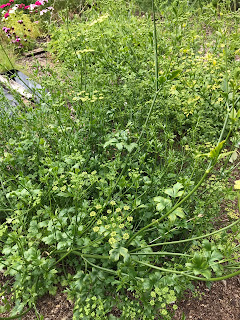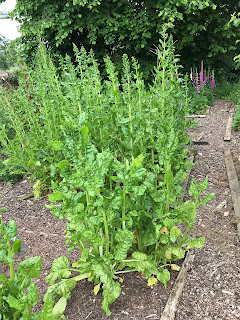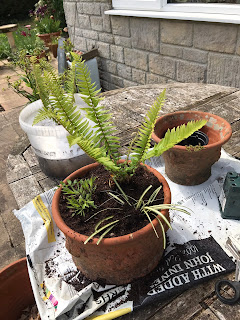 |
| The builders' sack |
One of the difficulties of no-dig gardening is the amount of compost needed to keep the soil in good heart. There’s no way I can produce enough from my two ‘dalek’ bins and the hotbin (which, after a slow start in spring, I’ve finally got up to a decent temperature); one ‘dalek’ is always slowly cooking away while the other receives kitchen waste and such garden material as I can stuff into it, prior to the contents being transferred to the other bin for longer-term ‘cooking’, but they’re not large enough to produce the necessary volume of compost. Last year I trialled using an old white plastic builders’ sack which originally arrived with a load of stone chippings for the drive, with reasonable success given the rough nature of much of the material I put into it, and this year it’s back in use, giving me a lot more space in which to compost stuff. So – I need more stuff to compost.
Charles Dowding, the no-dig guru, runs various courses
including one on how to produce compost (in volume). One of the participants on one of these
courses got so enthusiastic about the business of producing compost that he
declared that he now regarded his garden as primarily a source of composting
material. My initial reaction was mild
horror, but on reflection, I could see the point. And … I have a garden full of weeds – so why
not use the weeds to make compost?
I’ve always put some of my weeds in the compost bins, of
course, but the bins don’t reach the sort of temperatures that would destroy
seeding flowerheads or perennial roots, so a lot of weeds go into the council
waste bin (or, whisper it, over the fence into the field behind if they’re
weeds that came into the garden that way in the first place). But in fact flowerheads should be fine as
long as the seeds haven’t matured, and it’s not too onerous to cut off the roots
(and any seedheads) and compost the rest.
Some plants are too small or spindly to be worth the bother,
but I’ve been pulling up the chunkier weeds such as ground elder and woundwort
– both flowering but not yet seeding – for chopping up and adding to the
compost bins. There are also garden
plants going into the mix; the very large and substantial parsley and leaf beet
plants that are about to flower, for example.
I’m leaving one plant of each to collect seed from, but they are now too elderly for kitchen use and need removing. They’re
producing a great volume of green matter for composting. Woody material – an essential addition to any
compost mix – is less easy to come by, but prunings from my ‘Mary Queen of
Scots’ rose, which keeps flopping across the path, have also been added; it’s
not a very thorny rose, and the new growth is easy to cut up. I also scavenge
for any other shrub prunings to add, along with the odd bit of small cardboard. Material that I can manage to cut up into
fairly little pieces goes to the hotbin, but the rougher stuff is heading for
the builders’ sack, and I’m hoping for a decent amount of home-produced compost
this winter!
 |
| Parsley starting to flower ... |
 |
| ... and over-large leaf beet plants! |



